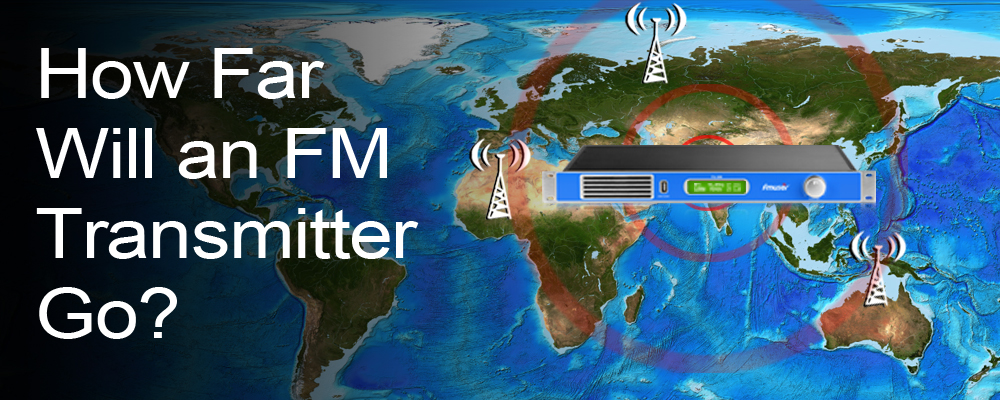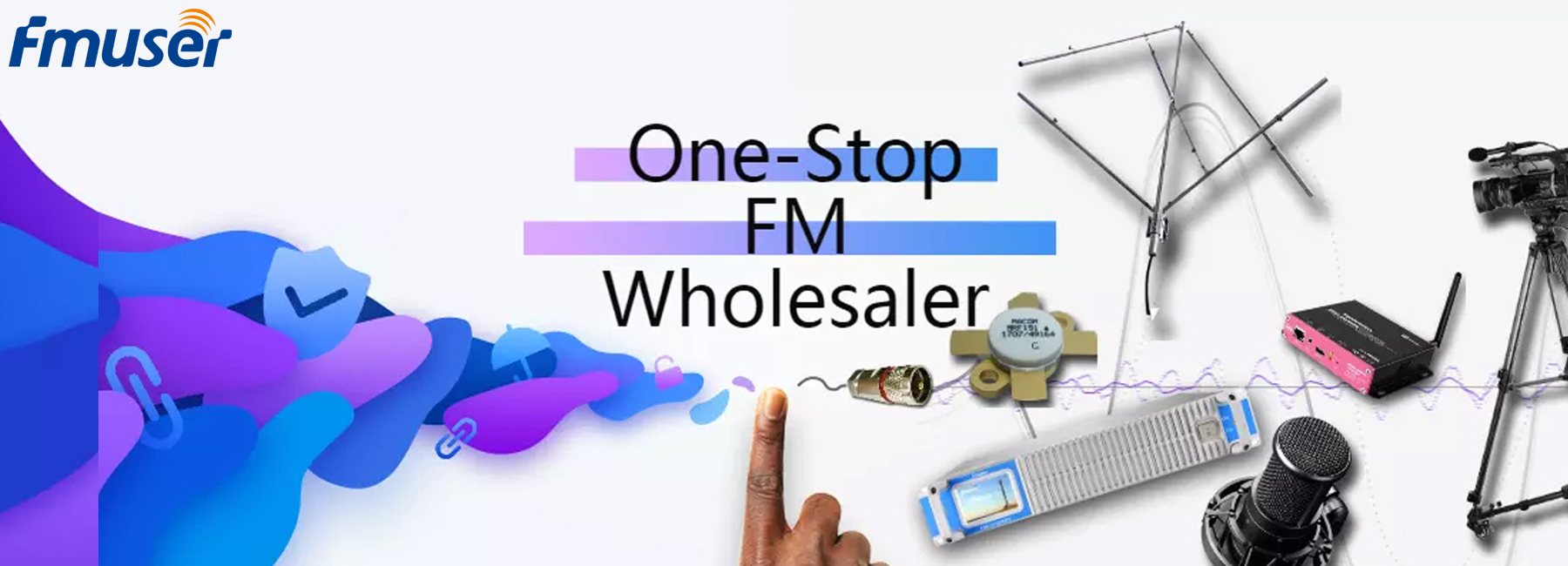
Hot tag
Popular search
How Far Can an FM Broadcast Transmitter Go?

"The coverage distance of broadcast transmitters with different power is different. Generally speaking, the greater the power of the transmitter, the wider its coverage. However, there are many factors that hinder the transmitter from reaching the theoretical coverage distance, This share will cover how FM broadcasting works with different power and the factors hindering their normal broadcasting."
If You Like It, Share It!
|
An Increasing Need for FM Radio Broadcasting in 2021 |
Chapter 1 - How FM Broadcasting Works
If you want to know the coverage of FM radio transmitters, you may need to understand how FM broadcasting works. As a professional radio station equipment manufacturer, FMUSER knows this quite well: FM radio broadcasting is inseparable from the development of transmitting and receiving sources, in which the transmitting side contains a variety of specific radio broadcasting equipment.
For example, radio station equipment such as a broadcast transmitter, radio antenna, RF filter, RF combiner, and RF filter is quite important for the operation of a radio station. All of those equipment works differently, for example, RF coaxial cable is used to prevent signal loss (also known as attenuation loss) and reduce EMI; an FM broadcast transmitter is used for electronic equipment generating RF AC; an FM broadcast antenna that is used for radiating radio waves generated by an FM transmitter, etc.
You may still have doubts: how do those radio station equipment work together? Let's hear it from FMUSER technical team!
An Increasing Need for FM Radio Broadcasting in 2021
The Next is How FM Broadcast Transmitter Works? | Click Here
The radio signal transmitted by FM radio transmitter plays an important role in the operation of modern high-speed Internet and mobile technology. Especially at present, the global epidemic is becoming more and more rampant. Contactless radio broadcasting services such as the drive-in church and drive-in theater have once again proved their values.
There is an increasing demand in 2021 for FM radio broadcasting services all over the world, A large number of FM radio stations came into being, which also made many radio station equipment manufacturers realize that the epidemic has become a key driver of global radio broadcast equipment wholesale business surge, which is enough to prove that for those radio broadcasting equipment wholesalers, radio broadcasting equipment dealers or FM radio station operators, FM broadcast transmitter is one of the most basic and most important radio station equipment in radio broadcasting. and of course, it is also the most profitable radio station equipment in the wholesale business.
The niche markets of radio broadcasting equipment are different. For FM radio transmitters, even in the 21st century with the rise of smart technology, people's lives are surrounded by a large number of smart technology derivatives such as smartphones.
An interesting phenomenon: your friends may have never used a radio before - those obsolete devices appear to be useless: It needs manual adjustment. It can only receive boring radio programs without pictures, and the noises produce from time to time. This is not surprising for people who have smart devices living in cities, but for people in remote areas, especially in the underdeveloped area without smartphones, TVs, etc, radio is simply the best way of entertainment. For those interested in electromagnetism, an FM radio transmitter is also an excellent tool.
How does FM Broadcast Transmitter Works?
The Previous is An Increasing Need for FM Radio Broadcasting in 2021 | Click Here
The Next is Different Between Personal and Commercial FM Transmitters | Click Here
Many people Google this question, but most of the search results look quite complex. In fact, radio transmitters generate the carrier signal at a specific frequency through the oscillator, and then the FM signal is transmitted through the FM antenna to outer space. Note that when a specific signal needs to be controlled, a voltage modulator is used. In the absence of an FM modulator, the frequency signal is transmitted at a predefined frequency.
Structurally, the mechanism behind the operation of the radio transmitter depends on the oscillator, because the oscillator is a device for generating the carrier signal. In addition to the oscillator, there is also a power supply device for providing the electrical signal, a modulator for adding information to the carrier, an amplifier for increasing the carrier power, and an antenna for converting the amplified signal into radio waves.
From the radio signal transmitting end, It is not difficult to see the complete workflow of radio broadcasting:
- The power supply enables the radio broadcast transmitter to obtain an electrical signal. At this point, we can adjust those frequency knobs and other keys to operate the transmitter
- The oscillator generates an alternating current. The alternating current generated by the oscillator is so-called the carrier wave.
- The modulator will add information to the carrier wave. The modulator slightly increases or decreases the frequency of the carrier (in the case of FM), while in the AM transmitter, the amplitude of the carrier varies in proportion to the modulated signal.
- RF amplifier will increase the power of the carrier wave. The stronger the amplifier function in the transmitter, the wider the broadcast coverage is allowed by this radio broadcast transmitter
- The impedance matching (antenna tuner) circuit transfers power to the antenna by matching the impedance transmitter to the antenna (or the impedance transmission line efficiently to the antenna). If these impedances are not equal, it will lead to a situation called a standing wave, in which power is reflected back from the antenna to the transmitter and is wasted, sometimes the broadcast transmitter may get overheated and break down.
- The broadcast antenna will convert the amplified signal into radio waves. A radio broadcast station with a stronger broadcasting tower may have better broadcast coverage.
- When sound is converted into sine waves and transmitted, the process of transmitting radio signals occur. The length of the sine wave is changed by frequency adjustment to transmit it to the FM receiver.
- The detector in the radio then converts the sine wave of the radio station into sound, and the sound amplifier increases its volume.
If you have learned about the classification of radio station equipment and their respective working principles before, you will know that the audio programs broadcast from the radio actually go through a seemingly complex but very simple process
The signal begins its journey in the form of a sine wave. When its journey began, there was no encrypted information in it. When information receives an electromagnetic signal, it is recorded. These electromagnetic waves are stronger than mechanical waves because they can pass through a vacuum at the speed of light. FM stands for frequency modulation, which means it can reproduce sound from the source. This is why FM stations can play high-quality music channels.
Sometimes we can't hear the radio. This is a transmission failure caused by a short wave. Short waves travel in a straight line away from the earth's crust. Because the earth is round, the signal will be interrupted. Usually, mountains, tall buildings, and even the installation height of FM broadcast antennas may become factors hindering radio signal transmission during radio signal transmission.
Difference Between Personal FM Transmitters and Commercial FM Transmitters
The Previous is How FM Broadcast Transmitter Works? | Click Here
If you want to know more about FM transmitters and ask for a definition, well. here's what you need:
- Amateur FM transmitter for personal use, click to visit
- Professional FM transmitter for commercial use, click to visit
The common application scenarios of the former are electronic equipment, sound system, wireless internet router or electrical or scientific projects in schools, The power of these FM transmitters is very small and the function is simple. You can even use these FM transmitters to play music stored in your mobile phone at FM frequency. The latter is often used in professional television and radio stations, such as provincial radio stations, community radio stations, radio stations of drive-in churches, and radio stations of drive-in theaters.
You can easily find those personal FM transmitters on some large shopping platforms, most of which are civilian FM transmitters for car radios at moderate prices.

However, find a budget FM broadcast transmitter for radio stations is not easy, I mean, a real good transmitter with high quality. Fortunately, As a one-stop radio station equipment manufacturer, FMUSER is able to provide all kinds of equipment in a radio station, from the broadcast antenna to high power RF filters. Contact their experts, They can help customize the broadcast solutions you need.
Back to An Increasing Need for FM Radio Broadcasting in 2021 | Click Here
Frequently Asked Questions
What are transmitters and receivers used for?
Radio transmitters and receivers are precise electronic devices that manipulate electricity resulting in the transmission of useful information through the atmosphere or space. In FM radio broadcast, transmitters refer to FM radio broadcast transmitters and TV transmitters, which are mostly seen in the engineering room of radio broadcast stations.
What are the types of radio broadcasting?
Radio broadcasting can be divided into AM, FM, Pirate Radio, Terrestrial digital Radio, and Satellite. With the exception of amplitude modulation (AM), Frequency Modulation (FM) is one of the most popular types of radio broadcasting around the world.
What is the function of the FM broadcast antenna?
The FM broadcast antenna is divided into transmit terminal antenna and receiving antenna. The transmitting end antenna can convert the electrical signal to radio waves, and the receiving end antenna converts these radio waves signals into electrical signals.
What are three types of antenna types?
Common antenna types have metal bars and dish antennas. While there are typically several different types of antennas in the radio station equipment market: directional, omnidirectional, and semi-directional.
Back to Content | Click Here
Related Posts:
- Why You Must Have an FU-15A FM Broadcast Transmitter for the Drive-in Church?
- What is "Must-Have" Broadcast Equipment in a Radio Rack Room?
Like it? Share it!
Tags
Contents
Related Articles
CONTACT US


FMUSER INTERNATIONAL GROUP LIMITED.
We are always providing our customers with reliable products and considerate services.
If you would like to keep touch with us directly, please go to contact us




